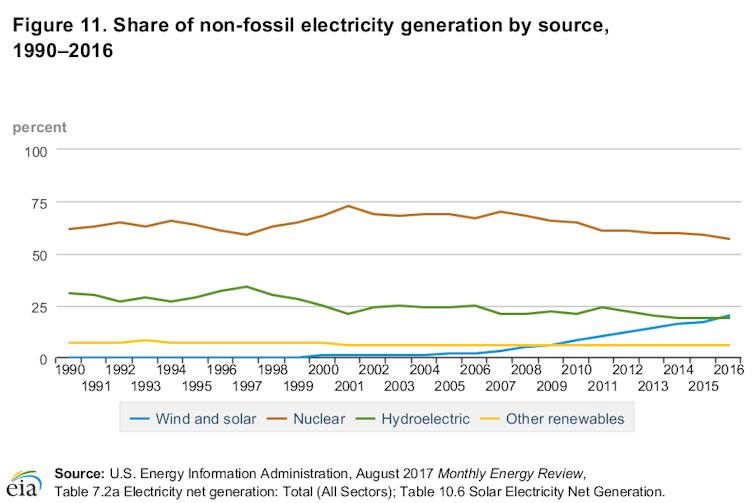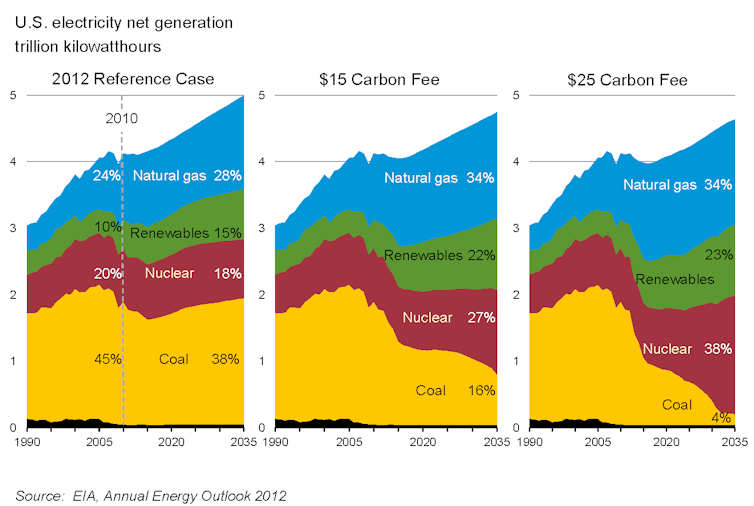To slow climate change, the US needs to address nuclear power's dismal economics
- Written by Tim Profeta, Director, Nicholas Institute for Environmental Policy Solutions and Associate Professor of Practice, Duke University
In late December 2017, the Georgia Public Service Commission faced a major decision: whether to cancel construction of two nuclear power reactors at Plant Vogtle, near Waynesboro, which had been plagued by delays and escalating costs.
Earlier in the year, utilities in South Carolina abandoned work on two reactors[1] that also were behind schedule and over budget. Vogtle is now the only large-scale nuclear construction underway in the United States.
Georgia regulators voted unanimously[2] to allow construction at Vogtle to continue. But they also increased the financial exposure of Georgia Power, the largest investor in the plant, by reducing costs that the company would be allowed to charge to its customers by US$1.7 billion.
Nuclear advocates called the vote a win[3] for the economy and the environment. In reality, however, it says more about the challenges facing the nuclear industry in the 21st century. I have worked for years on proposals to mitigate climate change, first in the U.S. Senate and now at Duke University. If nuclear power is to be part of a U.S. climate change strategy over the next century, policymakers must address its increasingly precarious economics.
 Almost all U.S. nuclear plants would require license extensions past 60 years to operate past 2050.
Almost all U.S. nuclear plants would require license extensions past 60 years to operate past 2050.
Struggling to compete
Many experts predict[4] that Vogtle will be the last traditional light-water reactor commissioned in the United States. The challenge is largely economic. According to the Department of Energy, the cost of generating electricity from newly constructed nuclear plants is almost double[5] the cost for power from a new natural gas combined-cycle plant – the highly efficient type that utilities are most commonly building now.
Natural gas combined-cycle plants aren’t just outcompeting nuclear power based on price. They also give power system operators flexibility to adjust quickly to the ebbs and flows of intermittent renewable sources, such as wind and solar power. Nuclear plants are designed to run more than 90 percent of the time, but can’t ramp up or down on short notice.
It is hard to make a business case for building new nuclear plants, even in regulated states like Georgia and South Carolina where utilities are allowed to recover construction costs from their customers. In deregulated Northeast and Midwest power markets, where generators compete to deliver electricity at the lowest cost, no new nuclear unit has been permitted for construction since 1977.
How essential is nuclear power?
Although the Trump administration is slowing or reversing its predecessor’s climate change policies, recent polls show that a majority of Americans believe climate change is caused mainly by human activities[6] and want the government to take action[7] to slow it. State regulators are starting to factor future damages from carbon emissions[8] into energy decisions.
Today about 20 percent of U.S. electric power, and 60 percent of our zero-carbon electricity, comes from nuclear generation. Nearly half of U.S. nuclear plants are at or near the end of their 40-year licensed operating lives. These units have received 20-year license extensions[9], but starting around 2030 they will reach their 60-year limits. At this point, they must receive a second license extension[10] or retire.
The owners of at least three units[11] plan to pursue second renewals. But others will not want to contend with the economic and engineering challenges of running reactors into their eighth decade. Some may be denied new licenses due to age-related safety concerns.
Many analyses suggest that nuclear generation is essential for reducing U.S. carbon emissions. In late 2016, the Obama administration published a Mid-Century Strategy for Deep Decarbonization[12], designed to reduce U.S. greenhouse gas emissions 80 percent or more below 2005 levels by 2050. Every scenario called for expanding nuclear power. A 2016 study[13] by the Rhodium Group[14], an international consulting company, projected that if all “at risk” U.S. nuclear plants retire by 2030, greenhouse gas emissions from the U.S. power sector will double from 2020 to 2030.
 Although wind and solar power are growing, nuclear power remains the dominant source of U.S. nonfossil electricity generation.
Although wind and solar power are growing, nuclear power remains the dominant source of U.S. nonfossil electricity generation.
My colleagues at Duke University’s Nicholas Institute for Environmental Policy Solutions have examined the potential impact of nuclear plant retirements in the Southeast[15], where they provide about one-quarter of our region’s electricity. They concluded that utilities should explore how the potential loss of these plants interacts with other regional challenges, and that southeastern states should start planning now for the potential loss of their largest carbon-free generation source.
The case for pricing carbon emissions
What’s the best way to resolve this tension between nuclear power’s failing market prospects and its importance to U.S. climate strategy? The Vogtle decision offers some lessons.
By moving the project forward, Georgia regulators explicitly recognized the importance of fuel diversity and the long-term benefits of reliability and carbon-free generation. But they also conditioned approval on continuation of federal tax credits for generating power from new nuclear plants, which were extended in a budget bill enacted in early February[16]. In effect, they recognized that nuclear offers societal benefits worth underwriting.
This step is critical because new nuclear power plants are unlikely to be built without some mechanism for monetizing social benefits from carbon-free generation. In Georgia, regulators decided to socialize the cost by allowing Georgia Power to pass some (although not all) construction expenses on to its customers, and to assume that the nation’s taxpayers would share some of the cost through the extension of federal tax credits.
It could be cleaner and more direct to develop a market-based mechanism that puts a price on the carbon emissions that nuclear power avoids. Such a policy would typically require utilities to either buy permits to emit carbon or pay a tax on carbon emissions. This approach would reward all low-carbon energy sources – but if it was sufficiently robust, it could change the economics of nuclear power.
 A carbon tax would penalize high-carbon fuels such as coal, and reward low-carbon and carbon-free sources such as natural gas, nuclear power and renewables.
A carbon tax would penalize high-carbon fuels such as coal, and reward low-carbon and carbon-free sources such as natural gas, nuclear power and renewables.
Illinois[17] and New York[18] are taking a narrower approach that requires utilities to produce specific fractions of the electricity they supply from zero-carbon sources. This strategy ensures a market need for some zero-emitting power. New Jersey lawmakers are debating a bill[19] that would provide economic credit to utilities for generating carbon-free electricity from nuclear plants.
Another strategy could be to aggressively promote mature new nuclear reactor designs that could take up some demand currently met by retiring plants. New, more flexible small modular reactors[20] could be competitive in the modern marketplace, but are still under development. Helping these technologies mature at a pace that might fill the coming void from looming nuclear retirements would require aggressive efforts to promote their demonstration and deployment. Recent studies[21] suggest that with such support, these new designs can become competitive in the market in the coming years.
Controversy over completing Vogtle demonstrates how difficult the current environment is for nuclear power. It will require proactive and aggressive strategies to maintain nuclear power’s role in the electric grid and avoid opening a gaping hole in U.S. climate change strategy.
References
- ^ abandoned work on two reactors (www.nytimes.com)
- ^ voted unanimously (chronicle.augusta.com)
- ^ called the vote a win (www.nei.org)
- ^ predict (www.washingtontimes.com)
- ^ almost double (www.eia.gov)
- ^ caused mainly by human activities (climatecommunication.yale.edu)
- ^ want the government to take action (www.scientificamerican.com)
- ^ future damages from carbon emissions (insideclimatenews.org)
- ^ 20-year license extensions (www.nrc.gov)
- ^ second license extension (www.nei.org)
- ^ three units (www.nrc.gov)
- ^ Mid-Century Strategy for Deep Decarbonization (unfccc.int)
- ^ study (rhg.com)
- ^ Rhodium Group (rhg.com)
- ^ nuclear plant retirements in the Southeast (nicholasinstitute.duke.edu)
- ^ were extended in a budget bill enacted in early February (www.nei.org)
- ^ Illinois (www.nei.org)
- ^ New York (www.nei.org)
- ^ debating a bill (www.njspotlight.com)
- ^ small modular reactors (www.nuscalepower.com)
- ^ studies (innovationreform.org)
Authors: Tim Profeta, Director, Nicholas Institute for Environmental Policy Solutions and Associate Professor of Practice, Duke University

